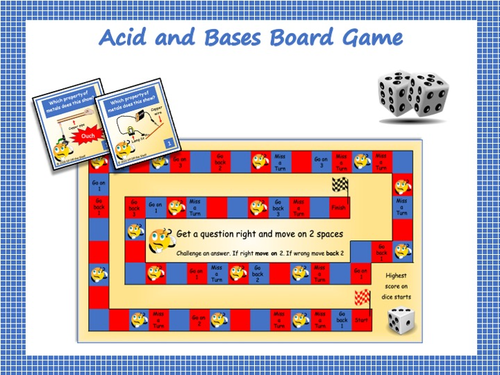







With 42 question cards on the properties of metals and non - metals, this is an enjoyable and challenging board game for up to six middle school players per set. It is suitable for all abilities.
Included in this Pack
- Game board
- 42 Question cards with questions of varying difficulty
- Teacher answer sheet
- Instruction sheet.
Preparation
- Photocopy Board onto A3 paper or card (Colour and greyscale versions included).
- Photocopy question sheets onto paper or card (Colour and greyscale versions included) and cut into question cards.
How to Play
- Highest score of dice starts
- Pupils take turns and work their way around the board following the instructions in the squares.
- Certain squares indicate that the pupil takes a question card from the face down pile. If correct they move on 2 spaces.
- If a player thinks an answer given by an opponent is incorrect they can challenge. If the challenge is correct the challenger moves forward 2 spaces. If the challenge is wrong the challenger moves back two spaces.
- In the event of a challenge, pupils are encouraged to consult their books but the teacher has a quick-check answer sheet.
Prior Knowledge Required
- Metals are conductors of electricity and heat while non - metals are insulators.
- Metals are strong (have high tensile strength) but non - metals are not.
- Metals are shiny when freshly cut or polished but non -metals are dull.
- Metals are sonorous (make a ringing noise when struck while non – metals do not.
- Metals are malleable (can be beaten into shape) and ductile (can be drawn into wires) but non – metals are neither and are brittle (shatter when struck.
- Iron, nickel and cobalt are magnetic but all non – metals are not magnetic.
- Metals are heavy which means they have a high have a high density because they contain a lot of particles. Non – metals are not heavy.
- Metals are all solids at room temperature, except for mercury which is a liquid, as they have high boiling and melting points. Of seventeen non - metals, all are gases except for five which are solids and one which is a liquid.
- Both metals are non – metals burn in oxygen to form the oxide.
Metal oxides are alkaline and non -metal oxides are acidic.
More high quality resources available here.
Elf Off the Shelf Resources
Something went wrong, please try again later.
This resource hasn't been reviewed yet
To ensure quality for our reviews, only customers who have purchased this resource can review it
Report this resourceto let us know if it violates our terms and conditions.
Our customer service team will review your report and will be in touch.
£3.00